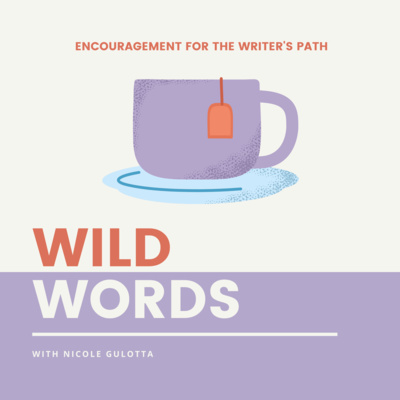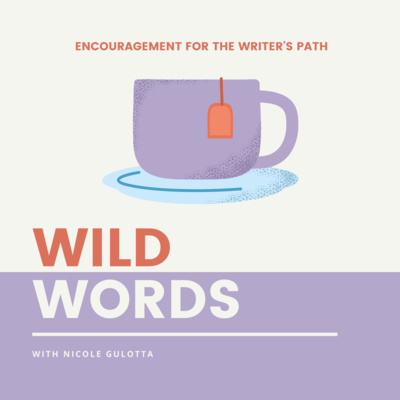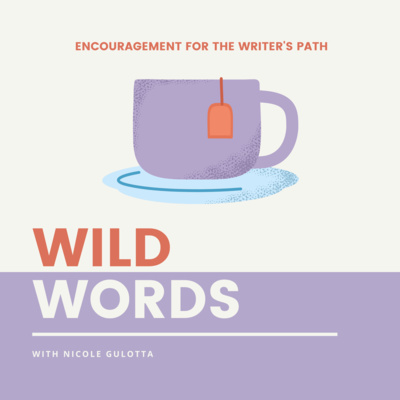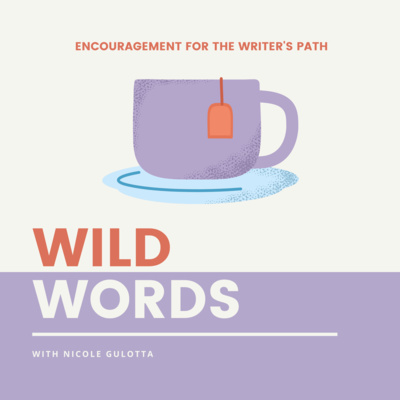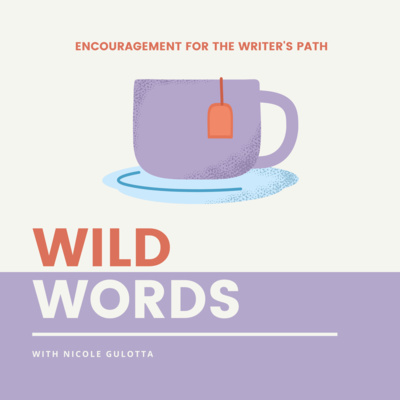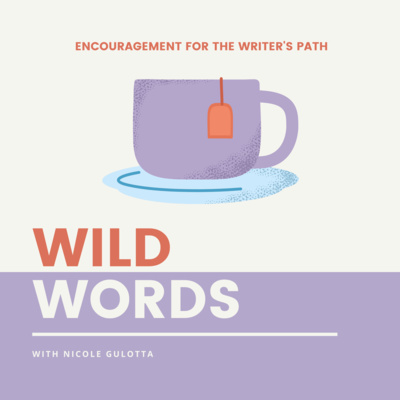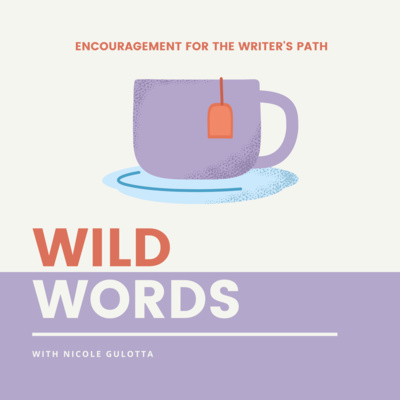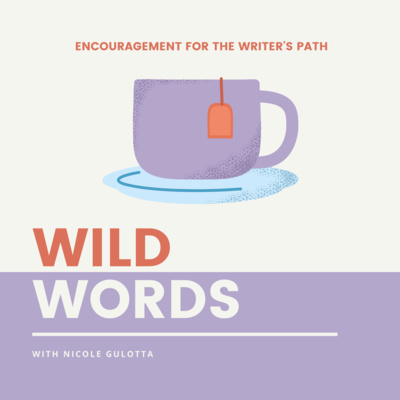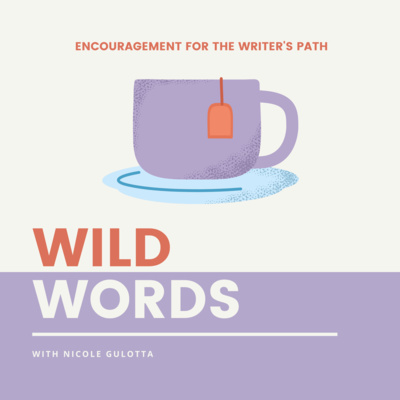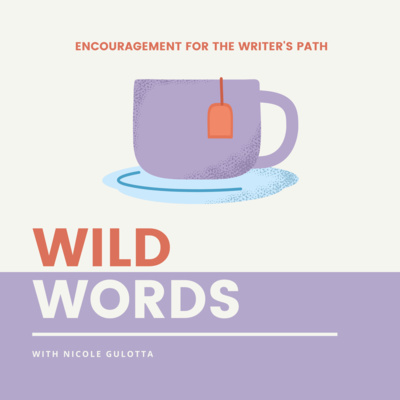Discover Wild Words
Wild Words

Wild Words
Author: Nicole Gulotta
Subscribed: 7Played: 134Subscribe
Share
© Nicole Gulotta
Description
The Wild Words Podcast helps writers embrace the season they’re in, create at their own pace, and care for their minds and bodies along the way. With conversations covering self-doubt to social media, host Nicole Gulotta (author of WILD WORDS and EAT THIS POEM) offers gentle encouragement for introverted or sensitive writers looking for a little support in an overstimulating world.
53 Episodes
Reverse
Welcome back to the Wild Words podcast! In Season 3, we're exploring the seasons of a writer's life through the lens of the global pandemic.
It’s not an understatement to say that the past two years have changed everything. Most writers I know, myself included, had to make drastic changes to their routines and expectations, and most of us are still trying to find a way back to ourselves and our work.
I’ll be sharing insights from my own writing life these past couple of years, as well as observations from the collective, plus encouragement for navigating the ebbs and flows of creativity with plenty of self-compassion along the way.
Subscribe on iTunes, Spotify, or your favorite listening app.
Sign up for my newsletter to be the first to hear updates: nicolemgulotta.com/newsletter
I wasn’t even sure I’d be able to record this episode, but I snuck in some time to share my thoughts about how to navigate creativity during coronavirus. Spoiler (although it’ll be no big surprise if you’ve been around long enough): my suggestions include doing a lot less, releasing expectations, wrapping up projects, and clearing the decks. This is all temporary, but we have to support ourselves in *this moment*.
If you’re a blogger, can you blog less frequently? Sending a weekly newsletter? Make it every other week (or monthly!). Producing a podcast? Maybe end the season early. Drafting your novel? Keep going, but remove the pressure. Writing 1,000 words per day? Try 250.
Basically, it’s time for a radical reorganization of our time and energy. Some of this will force our hand in ways that are endlessly frustrating. We won’t be able to meet the page as frequently, or give our characters undivided attention. Yet within these daily discomforts, we might have the opportunity to feel out what we truly need, step away from a piece, only to return with fresh eyes, make way for something new we might not have expected.
EPISODE HIGHLIGHTS
An update on what’s working for me (and what’s not)
Three important questions to ask yourself right now
Which creative seasons are most present in this period
Why I decided to end Season 2 of the podcast early
LINKABLE MENTIONS
The Wisdom of Anxiety by Sheryl Paul
Episode 18: Essentialism for Writers
What happens when you achieve a dream, then want to change your life? Writer Sonia Ruyts answered this question—and waded through liminal space—when she decided to close her brick-and-mortar yarn shop to pursue writing. On today’s episode she shares fresh ideas for establishing consistency in your writing practice, how she navigates self-doubt, the exercise she always starts her writing day with, and the intersection between slow fashion and creativity.
MEET SONIA
Sonia Ruyts holds a BA in Theatre from the College of Idaho. She is a former pastry chef and yarn shop owner who has returned to her first love: writing. Sonia explores themes of identity, loss, and transformation in her nonfiction writing and is currently at work on her first collection of essays. Sonia lives with her wife and two children—and their ever-expanding collection of pets—in the Pacific Northwest.
Connect:
SoniaRuyts.com
Instagram
Poshmark
EPISODE HIGHLIGHTS
How to navigate a cocktail of grief and shame
The foolproof way Sonia starts almost every writing session
Why studying English in college intimidated her (and the major she chose instead)
How she pivoted from pastry chef to yarn shop owner
The moment Sonia realized she wanted to close the store by the time she turned 40, and how she navigated the transition that followed
Avoiding and procrastinating vs. needing true rest
How choosing certain clothing items can help us connect with others, give us confidence, and help us feel comfortable during uncomfortable situations like readings, workshops, and more
LINKABLE MENTIONS
Business coach extraordinaire, Megan Flatt
Love and Trouble: A Midlife Reckoning by Claire Dedeier
Ethical fashion brand Elizabeth Suzann, and its popular Harper tunic
“The List of Words” exercise from Sarah Selecky
Did you know what you wanted to do after college? Neither did writer Kate Spring. My guest today took a winding path to becoming a farmer in Vermont, and today she’s running a farm, raising a family, and figuring out (through trial and error) the grounding practices that make it possible for her to return to the soil and the page year after year.
MEET KATE
Kate Spring is a writer and organic farmer at Good Heart Farmstead. She’s here to help you grow the organic farm or garden you dream of, and cultivate a flourishing creative practice. Because creativity is as essential as food.
Connect:
The Good Heart Life
Harvesting Words writing course
Instagram
EPISODE HIGHLIGHTS
Journaling as a conversation with the world
The book that inspired Kate to change her relationship to food
How a bad breakup and a summer internship set her on the path to farming
What “mud season” in Vermont teaches her about getting out of life’s ruts
The hardest parts about running a farm, and how burnout led to making some big shifts
Why Kate and her husband schedule writing retreats, rock climbing trips, and other self-care practices in advance
Reframing what “productive work” means, and why taking care of herself lays the foundation for all the other productive work
The power of starting the day with silence, tea, candles, and meditation
LINKABLE MENTIONS
Animal, Vegetable, Miracle by Barbara Kingsolver
The Omnivore’s Dilemma by Michael Pollan
Kundalini meditation with Sally Hope
Harvesting Words: an online writing course for farmers and gardeners
Have you ever wanted to write a children’s book? Heidi Fiedler has worked on more than 300 titles, and she’s an approachable and insightful resource on both the magical and business elements of writing for children. In our chat, Heidi shares the unique relationship between stories and illustrations that you only find in children’s books, the most important practice to build into your writing process that will help you grow (besides writing, of course), and how she quiets her inner editor.
MEET HEIDI
Heidi Fiedler does the deep thinking that’s needed to transform ideas into children’s books. She makes picture books, chapter books, and nonfiction for kids with curious minds and kind hearts. She believes books have the power to make us all feel a little less alone, and the best ones leave room for the reader's imagination. Whether it's a poetic picture book, a zippy early reader, or a kid-friendly take on the physics of time travel, her books are philosophical and filled with quirky tidbits, playful language, and lots of heart. It's been her pleasure to work on more than 300 titles for clients ranging from Target to Barnes & Noble. Her credits include 180 nonfiction books in partnership with Time for Kids, 90 picture books, chapter books, and middle-grade novels, plus a wide variety of activity books, and art and craft books. After working in publishing for nearly 15 years, she’s so excited to see her own picture books and chapter books making their way into the world.
Connect:
HelloHeidiFiedler.com
Heidi’s books
Instagram
Pinterest
Twitter
EPISODE HIGHLIGHTS
Why she hesitated going into publishing (even though everyone around her suggested it)
Her trajectory from a book seller to a book buyer to a book editor (and why her brain is wired for children’s publishing
Heidi’s dream for children’s books to have more “crazy/strange/weird” stuff…
Reading a children’s book? You’re actually reading two stories.
The unique relationship between stories and illustrations that you only find in children’s books
The tell tale sign you need to narrow down your story idea
The book Heidi feels is the holy grail of children’s book writing craft
The most important practice to build into your writing process that will help you grow (besides writing, of course)
All about “The Idea Sanctuary” and a “Nebula Notebook”
How the liminal space of waiting to adopt helped make space to build her freelance business
Heidi’s strategies for navigating being a writer, editor, mom, and business owner
How she quiets her inner editor
Editing strategies that don’t involve a computer
The subtle ways she knows it’s time to return to a project that’s been set asideHow she shifted from being a writer who didn’t always enjoy writing, to a writer who takes joy and pleasure in it
LINKABLE MENTIONS
Angelina Ballerina by Katharine Holabird
The Magic Words by Cheryl Klein
How do we build a community around our work? For writers seeking long-term support for their craft, this is an essential question and one I believe can be answered, in part, with newsletters. It’s an intimate, direct channel to readers who are eager to hear from you, and one of the best ways I know to build relationships that stand the test of time. I started back in 2013 with no strategy and no plan and really just winged it for a year before I got my act together. In January I surveyed 100 writers about newsletters and most responded with comments like: I don’t know where to start. I’m waiting until I finish my book. I don’t have anything to share right now. I’m afraid people will unsubscribe. They (81%) also said they’d either written a book or wanted to write a book, which begs the question: Who will read it? People who know you. People who you’ve invited into your world. People who have followed your journey. The truth is, we need to build trust and nurture relationships long before we have something to sell or promote, and on today’s episode, I’m sharing 3 mistakes writers make when starting a newsletter + announcing my free masterclass to help: Nurture Your Newsletter.
EPISODE HIGHLIGHTS
What I would do differently If I started a newsletter today
The essential mindset shift to make before you begin
Why you should start a newsletter now—even if you don’t have a book yet
We’re conditioned to do more—more blogging, more guest posting, more podcasting, more newsletter writing, more publishing, more speaking—but what if there was another way to get where we want to go? In 2016, a stack of sticky notes and an empty wall helped me decide what to do next creatively. Today I’m walking you through this simple exercise, and sharing how an essentialist mindset (aka “less but better”) can improve your writing life.
EPISODE HIGHLIGHTS
How a stack of sticky notes and an empty wall helped me decide which creative project to pursue next
An exercise to get clarity on what to write (and why)
Why the popular question “Where do you see yourself in five years?” is the wrong approach for navigating your writing life
LINKABLE MENTIONS
Essentialism: The Disciplined Pursuit of Less by Greg McKeown
Do Less: A Revolutionary Approach to Time and Energy Management by Kate Northrup
Do you really need an MFA? No, but you do need a framework for making progress. DIY MFA is a book and community created by author, speaker, and entrepreneur Gabriela Pereira. We chat about the key pillars—write with focus, read with purpose, and build your community—and tackle topics like self-doubt, guilt, and how to survive conferences as an introvert.
Gabriela Pereira is an author, speaker, and entrepreneur who wants to challenge the status quo of higher education. As the founder and instigator of DIYMFA.com, her mission is to empower writers, artists and other creatives to take an entrepreneurial approach to their education and professional growth. Gabriela earned her MFA in writing from The New School and speaks at college campuses and national conferences. She is also the host of DIY MFA Radio, a popular podcast where she interviews bestselling authors and book industry professionals and author of the book DIY MFA: Write with Focus, Read with Purpose, Build Your Community.
Connect:
Read: DIY MFA
Listen: DIY MFA Podcast
Instagram
Twitter
Pinterest
Facebook
EPISODE HIGHLIGHTS
Why necessity inspired Gabriela to start DIY MFA
How to use an “Angst Jar” to help overcome with The difference between reading for pleasure and reading for purpose
How to build a writing community (and why you should)
The 10% rule for creating achievable writing goals
Why you need a personalized reading plan (and how to create one)
How to survive conferences and events as an introvert
Why she plans tomorrow today
LINKABLE MENTIONS
Books mentioned on the show: The Book of Three by Lloyd Alexander, The Artist’s Way by Julia Cameron, Travels With Charlie, On the Road, The Alter Ego Effect by Todd Herman
The 10% rule, inspired by Guy Kawasaki and James Scott Bell
The psychological phenomenon of Parkinson’s Law
North Carolina Writers’ Network
Big dreams are popular these days. Write the bestseller! Speak in front of thousands! Get 1 million downloads! How about we take a hard pass and focus on our inner knowing instead? The fear of missing out (aka FOMO) is a powerful force in our creative lives, but when we intentionally choose small (like serving the audience we already have) and focus on staying present, it’s a lot easier to weather self-doubt when it arrives.
EPISODE HIGHLIGHTS
Two writing dreams of mine that have never materialized (and why I’m OK with it)
A quick exercise to figure out what you really want
The self-doubt spiral I experienced a few months before Wild Words was published
LINKABLE MENTIONS
Everything Is Figureoutable by Marie Forleo
Poets & Writers Magazine
Alisha Sommer and her family recently moved to California from the Midwest, and it was a dream six years in the making. We talk about the challenges (and surprising benefits) of liminal space, learn about a daily writing ritual she’s been doing for nearly three years, why she gets up so early, navigating the “both/and” space, and the art of the evening bath. | Pick up a copy of Wild Words wherever books are sold.
Alisha Sommer is a Bay Area freelance writer and photographer who has a gift for holding sacred space, for deep listening, and for seeing the ordinary in extraordinary ways. In the past, Alisha founded and edited a print literary journal (Blackberry: a magazine), published personal essays, creative nonfiction, and poetry for a variety of online and print publications, ghostwritten, collaborated with Angela Burke for Black Food & Beverage, and taught at Squam Art Workshops. Currently, she hosts creative gatherings in Sonoma, CA like the Fever Dreams Collective Retreat with Jennette Nielsen, and facilitates the online writing workshop liberated lines with Robin Sandomirsky.
Connect:
AlishaSommer.com
Sommersalt Blog
Instagram
EPISODE HIGHLIGHTS
The daily writing ritual Alisha’s been doing for almost 3 years
Thoughts on her 4:45 am wake up call
The intentional (and practical) steps she and her family took to move from the Midwest to the West Coast
The unexpected moment she knew she could actually live in California
Upsides to moving through liminal space
The challenges making friends as an adult (and an introvert)
What it looks like to bring your creativity to the workplace
Navigating the “both/and” space when you make a big life change (even if it’s something you want)
Why creative constraints can actually be helpful
The art of the evening bath
LINKABLE MENTIONS
The OnBeing podcast episode that inspired Alisha to start a daily journaling practice
The Artist’s Way by Julia Cameron
Every book, story, or poem has a point of entry. What are yours? Inspired by Jane Hirshfield’s poem “The Envoy,”—“there are openings in our lives of which we know nothing”— we’re starting Season 2 with an exploration of origin stories. I’m sharing a few of mine, with suggestions for accessing even more awareness in your own writing life.
EPISODE HIGHLIGHTS
How Jane Hirshfield’s poem “The Envoy” inspired a trip down memory lane
Why we should write down the thoughts we have in the middle of the night
A story that didn’t make it into the Eat This Poem cookbook after all
How to cultivate awareness in our writing life
LINKABLE MENTIONS
“The Envoy” by Jane Hirshfield
Florida Poems by Campbell McGrath
10 surprising surfaces famous writers have written on
Every December there are two things I like to do to support my creativity in the year ahead: conduct a writing annual review, and choose a word for the year.
EPISODE HIGHLIGHTS
How I adapted a corporate ritual for my creative life
Why writers need to become their own director of HR
The #1 thing I recommend doing when trying to make space for writing
How to choose a word for the year (and why you should)
LINKABLE MENTIONS
How to write 32,000 words without really trying
Susannah Conway’s Word of the Year course
Choosing a word with Claire Diaz Ortiz
Media bombards us every second of every day. With so much noise stimulating our brains, nervous systems, and hearts, how might we return to ourselves? The answer, in part, is rewilding. My guest today is writer Lily Diamond, who shares her take on the essential practice of remembering who we are, and offers suggestions for how to cope with the world around us.
MEET LILY
Lily Diamond is a writer, photographer, and proponent of rewilding in the kitchen and beyond. In 2012, she created the award-winning, much-beloved blog Kale & Caramel, which turned into a bestselling memoir-cookbook. Lily grew up on Maui and graduated from Yale University. She lives in California, and is the co-host of the podcast What’s Your Story?, and co-author of the forthcoming guided journal of the same name.
Connect:
Instagram
Twitter
Pinterest
Facebook
YouTube
EPISODE HIGHLIGHTS
Why Lily starts her day outside (and her favorite beverage of the moment)
How she separates communications threads for her various projects
Ways to cope with anxiety and stress
Imagining a world where we pull ourselves back into ourselves, and know who we are
A conversation about social media boundaries and creativity
LINKABLE MENTIONS
Lily’s Instagram post that inspired our conversation
The famous green milks
See question 24 for how America pronounces caramel
If Women Rose Rooted by Sharon Blackie
The recent extinction of 3 billion birds in North America
Nobody Walks In L.A. movie trailer
The art of rewilding
A favorite notebook, a delicious tea blend, a piece of software, a trusty pen. These are all standard tools a writer needs in her toolbox. But for the past two years, I’ve relied on something else to ignite my writing practice, and it’s a meditation technique that involves little more than lying down and taking a restorative nap. Learn more about this life-changing and non-negotiable tool in my writing life on today’s episode! | Sign up for Write With Intention, a FREE 7-day e-course introducing writers to yoga nidra meditation.
EPISODE HIGHLIGHTS
The experience I had in 2017 that changed everything
The difference between yoga nidra and traditional meditation
Why you might be approaching rest the wrong way
How to use yoga nidra meditation to support your creative life
LINKABLE MENTIONS
Episode 05: The Physical Toll of Writing feat. Elissa Altman
August Uncommon Tea
Blog post: Rest vs. Relaxation
Daring to Rest: Reclaim Your Power With Yoga Nidra Rest Meditation
Today’s guest is Andi Cumbo-Floyd, a writer and editor from Virginia’s Blue Ridge mountains. She’s written 11 books—10 are self-published—so we talked about the learning curve, self-publishing tips, how to promote your book, what to share in a writing newsletter, and what Andi would do differently if she were just starting out today. Andi also shares a big life decision she recently made that helped her make more space to write.
MEET ANDI
Andi Cumbo-Floyd is a writer, editor, and writing coach who lives in the Blue Ridge Mountains with her husband, turbo tot, three dogs, and three cats. She writes regularly about writing over at andilit.com.
Connect:
Instagram
Twitter
Pinterest
Books
Read: Love Letters to Writers
EPISODE HIGHLIGHTS
Why Andi and her husband decided to sell their farm
How writing supported her through a life-changing transition
What a writing routine looks like with a 15-month-old at home
Why she chose to self-publish 10 books, plus what she’d do differently if she were just starting out
Book launch advice
An ordinary drive around a farm changed the trajectory of her life (and writing life)
Why she doesn’t edit the same types of books she writes
SELF-PUBLISHING RESOURCES
Vellum book software
Draft2Digital
Kirsten Oliphant’s Create If Writing Podcast
Jane Friedman
BookBub, for book promotions
Mark Dawson’s classes on Facebook ads
Strangers to Superfans by David Gaughran
LINKABLE MENTIONS
Blog post: The Not-So-Final ROI On My Latest Book Launch
Madeleine L’Engle
The Slaves Have Names
Love Letters to Writers
My work isn’t good enough. No one but me cares about what I have to say. People will think the story is true. I’ll be judged. I’m not original. These are real fears from real writers, and on today’s episode I’m tackling them one by one, offering suggestions for how to reframe our thinking when self-doubt holds us back.
EPISODE HIGHLIGHTS
5 fears voiced by writers in my community
What Ruth Reichl can teach us about imposter syndrome
How a bookstore in Maine helped me see the bigger picture
How to play out your worst case scenarios
LINKABLE MENTIONS
Save Me the Plums by Ruth Reichl
The Season of Self-Doubt
Episode 06: Your Work Is Not a Good Fit at This Time
If you’re an introvert with a book to promote (hello, Season of Visibility!), how can you share your message without burning out? That’s the question I’ve been working to answer for the past several months. Learn the three areas I’m focusing on this time around, plus recommendations and reminders for the introverts among us.
EPISODE HIGHLIGHTS
The three areas I’m focusing on for book promotion
How I approach book launches so I don’t burn out
Why I haven’t scheduled any out-of-state events … yet
Something I used to believe about publishing (that I don’t anymore)
What finishing a book is really about
LINKABLE MENTIONS
Episode 02: Trusting the Timing of Your Creativity
Sign up for Over Tea, my encouraging writing newsletter
Writers like to stay behind the screen, but part of our work requires getting out there and embodying The Season of Visibility. If you’re feeling unsteady, Sonja Overhiser is a writer worth knowing. She’s built a creative business with her husband, Alex, and today she’s sharing tips for surviving live television spots, why she hired a publicist (even though she had a traditional book deal), and how writing helped her cope with a difficult adoption journey.
MEET SONJA
Sonja Overhiser has run the award-winning food blog A Couple Cooks with her husband, Alex, since 2010, and co-authored Pretty Simple Cooking, which has been named a best vegetarian cookbook by Epicurious and Food & Wine. A Couple Cooks was awarded the IACP Best Individual Blog award in 2019 by the International Association of Culinary Professionals, a professional food media association co-founded by Julia Child. A Couple Cooks has been featured on the TODAY Show, and in numerous national print and online publications, including Washington Post, Huffington Post, Oprah, Food & Wine, and Bon Appetit. As a healthy and sustainable eating advocate, Sonja works with the following organizations committed to improving planetary health and public health: Planetary Health Alliance, EAT Foundation, and True Health Initiative. She lives in Indianapolis with her family, where she is co-founder of the organization Indy Women in Food that champions women in the Indianapolis food industry, and has been featured as a trailblazing woman in food by the Indy Star.
EPISODE HIGHLIGHTS
Sonja’s transition from full-time technical writer to full-time creative business owner
How she used writing as a way to cope with a difficult period of liminal space as she waited to adopt her son
Tips for getting started with using video
The most important skill writers need to have—after strong writing, of course
LINKABLE MENTIONS
Sonja’s adoption story
Are you a Xennial?
Sonja and Alex’s Today Show clip
Learn your Enneagram type
If sending your work into the world makes you feel simultaneously elated and anxious, you’re not alone. Unfortunately, rejection is par for the course in the writer’s life, but I believe there are some tangible ways we can navigate it with more grace and less of an impact to our sensitive writer’s heart.
EPISODE HIGHLIGHTS
My reaction to a 1-star book review
How to view our fear from a more expansive vantage point
6 things to do when your work is rejected
LINKABLE MENTIONS
Sign up for Over Tea, my encouraging writing newsletter
After finishing her manuscript for Motherland, author Elissa Altman posted a hard truth about the writer’s life on Instagram: doing this work can take a physical toll on your body. Our conversation explores this important topic, including how she’s putting her body back together again after finding it left in shards from the emotional writing process.
ELISSA ALTMAN is the critically acclaimed author of Poor Man's Feast: A Love Story of Comfort, Desire, and the Art of Simple Cooking and the James Beard Award-winning blog of the same name and Treyf: My Life as an Unorthodox Outlaw. Her work has appeared in O, The Oprah Magazine, The Wall Street Journal, The Guardian, The New York Times, Tin House, The Rumpus, Dame Magazine, LitHub, Saveur, and The Washington Post, where her column, Feeding My Mother, ran for a year. She has been anthologized in Best Food Writing six times. A finalist for the Frank McCourt Memoir Prize, Altman has taught the craft of memoir at The Fine Arts Work Center in Provincetown, The Loft Literary Center, 1440 Multiversity, Ireland's Literature and Larder Program, and has appeared live on stage at TEDx and The Public, on Heritage Radio, and NPR. She lives in Connecticut with her family.
ElissaAltman.com
Instagram: @elissa_altman
Facebook
Twitter: @ElissaAltman
Books: Motherland, Treyf, Poor Man’s Feast
EPISODE HIGHLIGHTS
Elissa’s technique for using journal entries to create scenes
How a 10-year stint in the publishing industry ignited her creative spirit
The Instagram post that launched a conversation about the physical toll of book writing
Why writing is romanticized, but hardly romantic
The concept of negative space and silences in our writing
A self-care plan to prep for book publication
How writing is like an obstacle course
Who owns the right to tell a story?
LINKABLE MENTIONS
Memoirist Kathryn Harrison’s book The Kiss
Humorist and writer David Rakoff
The Instagram post that launched a conversation about writing and self-care
Elissa’s TED talk about how senior citizens are absent from the American food conversation
Fine Arts Work Center, Provincetown
The drunken lives of writers



